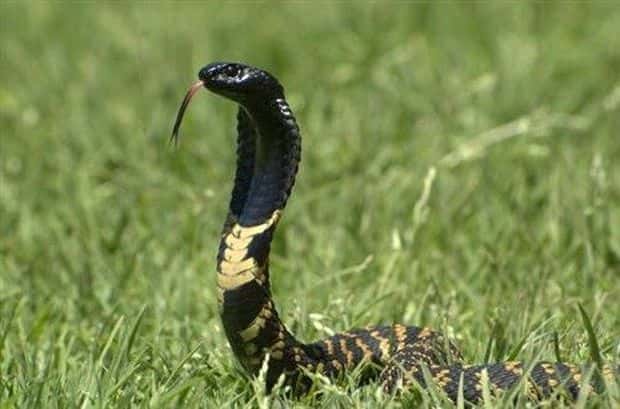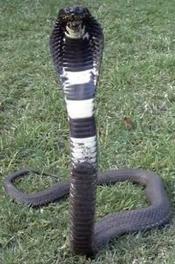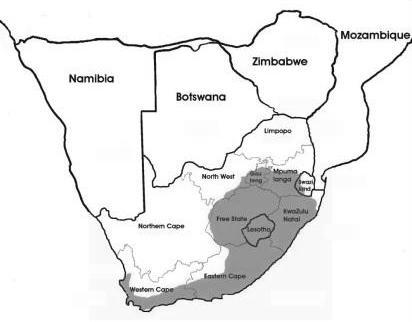RinkhalsHemachatus haemachatus |

Custom Search
|
They are also found in Lesotho and western regions of Swaziland with an isolated population believed to be located in the central Zimbabwe and Mozambique border.
The rinkhals has adapted to inhabit a variety of habitats, and can be found from the sea level to mountains at higher altitudes up to 2500 m. It is usually found in moist grassland with rainfall, where it's easier to blend into the surrounding environment. But it can also be found in swamps, marshes, moist lowlands and wetlands, is commonly found on the highveld regions avoiding bushveld regions. The rinkhals has also adapted quite well to human urban development. The species is also called the ringhals which derives from the Dutch “ring hals” meaning "ringed neck" because of the light color crossbands usually found around their throat. They are sometimes also called ring-necked spitting cobra for the same reason. The rinkhals is often confused with the cape cobra (Naja nivea), but it is shorter in length and bulkier in appearance. They are sometimes mistaken with other snakes also found in their range like the puff adder or even the deadly boomslang. The rinkhals is a small to medium sized snake species, it usually reaches 90 cm to 120 cm in length, but can reach up to 1,5 m. They are bulkier when compared to other similar sized cobra species.
Their head is short and pointed, with some resemblance to the australian death adders (genus Acantophis), although it isn't as distinct from the neck, and with fairly large, black eyes. The rinkhals coloration varies throughout its range, with some individuals being mostly black or greyish while in other regions they are light yellow or orangish in colour with brown or black bands. They do have a characteristic darker belly usually dark brown or black with 1 to 4 white, pale cream or yellow coloured crossbands on the throat area.Their scales are strongly keeled yet another distinction from true cobras. Much like the King cobra (Ophiophagus hannah) the rinkhals isn't a true cobra since it doesn't belong to the genus Naja like the indian cobra or the egyptian cobra. Instead the species belongs to the monotypic genus Hemachatus, they are however very closely related to the true cobra species. As usual the rinkhals is regarded as an aggressive snake, when in fact like most snakes they will do virtually anything to avoid a confrontation. In true cobra style the rinkhals will rear up and spread a hood and hiss loudly. They will also spit venom with extreme accuracy up to 2 meters of distance, usually aiming to the face or eyes. Sometimes they will convincingly feign death, and sometimes people get bitten when picking up what seems to be a dead snake, not a good idea. The rinkhals is usually a nocturnal species, but sometimes it may be observed basking in the sun during the day. Venom / Bite
The rinkhals venom is mostly composed of strong neurotoxins, but it has also as a small amount of cytotoxins.When compared to the venom of other African elapids, it's much more fluid with less viscosity, making it easier to spit. Their venom glands have a capacity of 80 to 120 mg. The estimated lethal dose is for humans is around 50 to 60 mg and the average yield per bite is around 100 mg. The LD50 values range from 1.1 to 1.6 mg/kg. Their venom effects are not as severe as those of other cobra species, and usually include pain, bruising and swelling in bite area, nausea, vomiting, drowsiness, vertigo and abdominal pain. However, if a bite occurs on an extremity like a finger there is a real danger of amputation, because of the bite's very severe local effects. Other neurological effects may also manifest including general paralysis and difficulty breathing, which can eventually lead to death. But since the rinkhals tends to spit rather than injecting venom there are actually few bites to humans. They are quite capable of aiming and usually spit their venom at the face or eyes, and if the eyes are hit the victim may experience an excruciating pain, blurred vision and even permanent blindness, if the venom is not washed off quickly. Its also uncertain that the rinkhals ever caused a human fatality, that being said any bite from one is potentially lethal and should be treated seriously. Dogs however get bitten quite often when they attack these snakes. These elapid snakes have fixed frontal fangs located on the upper jaw, with a venom canal running through each fang.The fangs are specially modified for spitting because the discharge hole is facing to the front at a 90-degree angle not down. This special feature allows them to spit or spray venom at an attacker, particularly targeting the eyes. But unlike true spitting cobras like the mozambique spitting cobra, that can spit venom in a horizontal position, the rinkhals has to rear up to spit venom. Diet / Feeding The rinkhals has a fairly diverse diet, feeding on almost anything it can catch and kill. They prey mostly on frogs or toads and rodents like rats, but will take small mammals, amphibians, birds and bird's eggs, lizards and even other snakes. Juvenile snakes feed primarily on lizard and toad eggs. Reproduction The rinkhals is quite unique amongst African cobra species since unlike other true cobras it is ovoviviparous. They don't lay eggs these are live-bearing snakes. The mating season occurs from June until August with the young snakes being born usually from late December up to late February or early March. During the mating season the males behave more aggressively, and they will fight for dominance with rival males. They go as far as sometimes even biting the female during copulation which can be fatal for the female. The rinkhals gestation period lasts around 5 to 6 months during which the embryos develop inside of the female’s body.They are kept within a clear membrane without an egg shell, until these baby snakes are ready to be born. During gestation the female does not eat particularly in the latter half of this period, because of her bulk. When the babies are fully developed, the female lays the embryos usually in an abandoned burrow. Then the hatchlings use a sharp egg tooth located on the snout to break off the protective membrane, and wander off to fend for themselves. They receive no parental care. The rinkhals gives birth around 20 to 35 young snakes, but as many as 65 hatchlings have been recorded in a single clutch. The young snakes are almost exact replicas an adult rinkhals, although much smaller, being only about 15 to 20 cm in length. They are usually gray-toned with characteristic white bands around the throat being usually very visible at birth, they become black when they reach about 1 meter in length. Conservation / Threats The rinkhals is considered a "Least Concern" species by the IUCN because of its large distribution, and is very throughout most of its range. These snakes aren't being impacted by any major threats, although they are collected for the international exotic pet trade this isn't considered a major threat. The current population trend is considered stable.
|
Scientific classification |
© 2014 Snake Facts About Us | Privacy Policy | Contact





